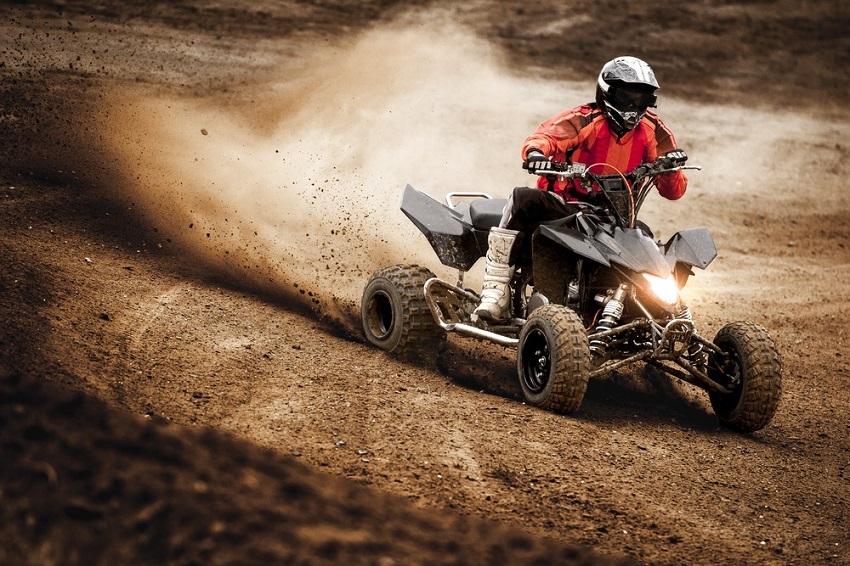Riding an all-terrain vehicle (ATV) is just as much fun as it sounds. These vehicles allow you to drive through all kinds of topography you can’t reach on foot. They can handle the sand, mud, ice and snow with ease, helping you see all the wonders of nature up close and personal. But leaving the paved road behind comes with great responsibility. You need to dodge oncoming obstacles and wear the proper ATV riding gear to protect your body from the elements. Use this guide to stay safe on the back of an ATV when you hear the call of adventure.
- Wear the Proper Clothing
You won’t have four doors and a roof over your head when you’re on the back of an ATV. These vehicles offer scant protection from the wilderness, so prepare to get dirty. Flying rocks, dirt and other debris can make it difficult to drive, so you need to wear a full-face or half-face helmet with goggles to protect your eyes, head and ears. Cover as much of your skin as possible to prevent scrapes, cuts and scratches. The outer layer should be durable enough to withstand wear and tear, so your clothing underneath doesn’t get covered in mud. Wear thick boots with deep treads on the bottom to navigate the trail on and off your vehicle. Wrap your hands in gloves with a firm grip to stay in control of your vehicle.
- Use Wireless Communication
Riding is always more fun when you’re in a group, but you need to be able to communicate with your fellow riders. ATVs can only accommodate one to two people, so you will likely need more than one vehicle to get everyone to your destination. You won’t be able to hear each other over the sound of the engine, so use an off-road communication device to keep in touch. Just speak into the device to send a message to the other people in your group. You don’t have to physically interact with the device to have a conversation. It uses voice recognition to connect to your phone or the other riders for seamless coordination every step of the way. It’s easy to get lost when there aren’t signs to guide the way. You might also lose service when exploring remote areas, so use a reliable Bluetooth headset instead. It doesn’t need access to the internet to function, so you can follow the path wherever it takes you.
- Go Off-Road and Stay Off-Road

Source: Wojciech Czekalski/Shutterstock.com
ATVs are only meant to be driven on designated trails and paths. They aren’t allowed on public roads or those intended for passenger vehicles. The only time it’s acceptable to drive on the pavement is when you are crossing the street to reach the next leg of the trail. ATV riding laws vary by state and county, so be sure to check with the local authorities before going for a ride. If you want to drive your ATV on the road, you need to add all the safety features of a normal passenger vehicle, including lights, turn signals, mirrors, a horn and a proper license plate.
- Limit Your Passengers
Unless you have a specialized ATV that can accommodate more than one person, you shouldn’t have anyone on the back of your vehicle. It may sound like fun to hop on the back of a moving vehicle when there’s no one around to tell you what to do, but the other person can easily fall off and injure themselves in the process.
- Stay to the Right
Respect the rules of the trail by staying to the right, just like you would on a paved road. You will likely encounter other riders going in the opposite direction, and you need to make sure you don’t run into each other. Give yourself plenty of time to stop when coming to a bend in the trail and keep your eyes peeled for other drivers. You don’t have a monopoly on the outdoors, so make sure there is enough space for everyone.
- Start Out Slow
The wilderness doesn’t come with a speed limit, but that doesn’t mean you should try to break the sound barrier with your ATV. Give yourself some time to get used to throttling your speed on the vehicle using your thumb. Taking turns too fast will only get you into trouble. You could also run over a nasty patch of dirt that could send you flying. Stay clear of obstacles when accelerating and work on shifting gears as you work up to higher speeds.

Source: Maciej Kopaniecki/Shutterstock.com
- Maintain Good Posture
You need to sit in the right position to properly operate the vehicle. The force of momentum is reversed on an ATV compared to riding a dirt bike or motorcycle. You will need to turn your body in the direction of where you want to go. Use an active stance when riding over uneven terrain to better absorb the turbulence, so you don’t feel the vibrations all over your body. This will also help you stay in control of the vehicle when the going gets rough. You can sit back down when the path smooths out again.
Nothing produces a thrill quite like riding an ATV. But riding an ATV isn’t the same as riding a bike. You need to learn how to master the power of the machine while navigating unpredictable terrain. Use these riding safety tips to stay in control regardless of what comes your way.






